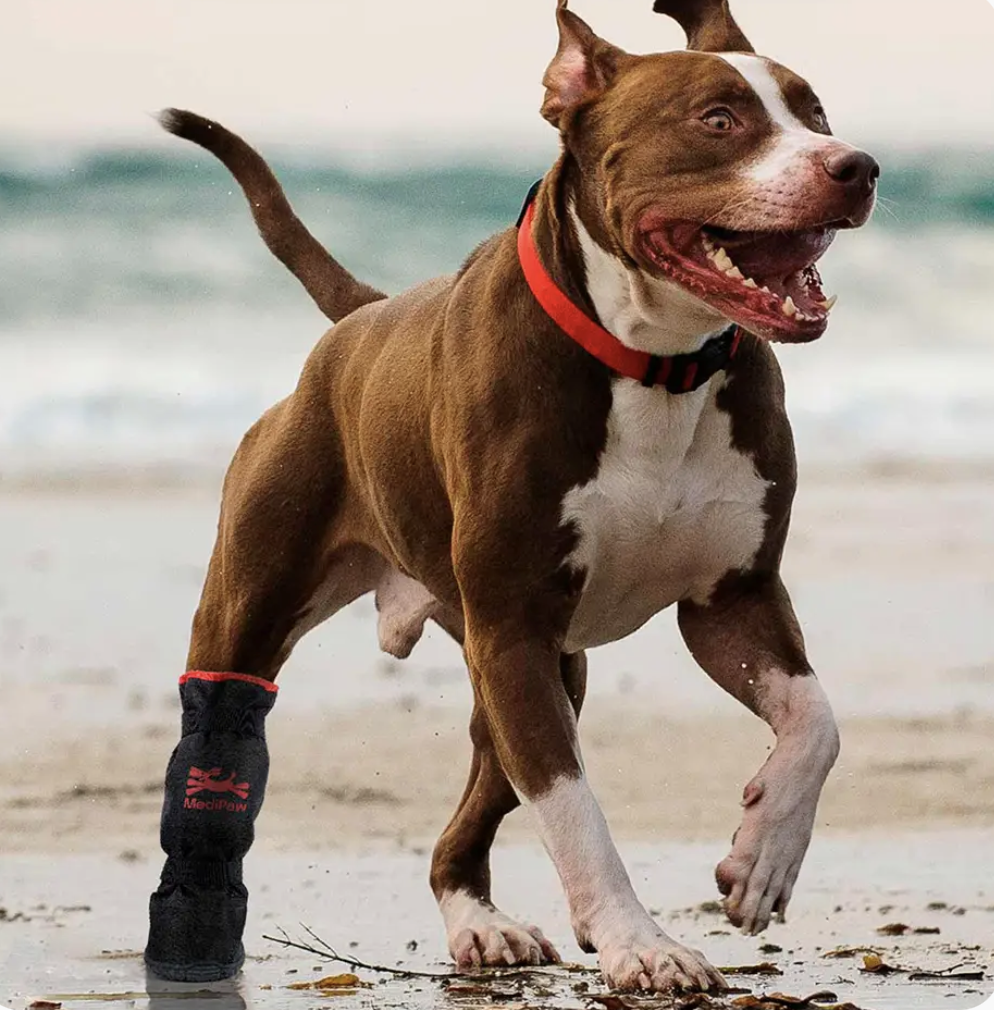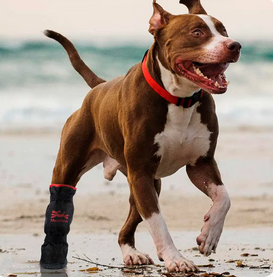10/10/2023
Protecting Your Dog's Paws in Hot and Cold Weather: The Benefits of MediPaw Boots
You may have seen little booties on dogs when it's wet or cold out. They look funny and cute, but are they necessary? Find out more about when dog boots, specifically MediPaw boots, might be a good idea.

Benefits of MediPaw Boots
With the growing popularity of dog boots, you might be wondering what all the fuss is about. MediPaw boots offer a wide range of benefits, especially if you have an active pup. Just like your own feet, your dog's paws are soft and prone to injury, especially if you take them running, hiking, or spending time out in extreme weather. Here's why MediPaw boots can be a great choice:
- Winter Time: During the cold winter months, they protect from ice and snow. If you live in an area where de-icers are used to melt snow and ice, be aware that some of them can cause chemical burns on paw pads. (You also don’t want your dog licking these chemicals off once you’re back indoors.) Salt crystals can also be sharp and uncomfortable to walk on. Furthermore, if your dog has furry feet that collect ice and snow between the toes, she may be more comfortable wearing MediPaw boots.
- Summer Time: Does it get dangerously hot where you live? Your pup may get burns on his feet when going for walks. A good test to see whether the ground is too hot: press your own hand against it for a few seconds. If you feel the ground and it seems hot to you, then that means that it will also be hot for your dog’s paws. If there is no shade covered or grass areas available for your dog to walk on, then it might be worth putting MediPaw boots on your dog to protect them from concrete burns. It is also important though to note that your dog does have sweat glands in their paw pads so be conscious of leaving boots on them for too long so they don’t accidentally overheat.
- Aging Dogs: As dogs begin to age, they may begin to drag their feet as they walk, which can damage their paw pads. Your veterinarian may recommend MediPaw boots for cushioning in such cases.
Are MediPaw Boots Necessary to Keep Paws Safe?
Dogs’ paw pads are generally pretty tough. While dog boots aren’t always necessary to keep paws safe, there may be times, places, and situations in which MediPaw boots are necessary to protect Fido’s paws, such as in extreme hot or snowy weather, when traversing rough terrain, or to protect your dog from allergies or when they have a cut paw, amongst others. However, if your dog won’t tolerate boots, there are other options – read on for more advice.
Tips for Getting Your Dog to Wear MediPaw Boots and Basic Paw Care
Training your dog to wear boots is not always an easy feat since there’s nothing natural about it. Initially, your pup might be fussy, but there are a handful of tips for getting Fido acclimated to their new gear:
- Introduce the MediPaw Boots to Your Pet: Once your dog is okay with you handling their paws, it’s time to introduce the MediPaw boots. Start by first showing your dogs the boots and letting them sniff their new gear. Placing the boots next to their food, bed, leash, or other favorite items is also a good way to get them acclimated and teach your pup to create positive associations with their boots.
- Put the MediPaw Boots On for Short Periods of Time: Before you set off on an adventure with your dog wearing their new gear, you’ll want to practice having them wear the boots around the house and for short periods of time. This is a good opportunity to introduce treats and positively reinforce the boots as they’re worn in short increments. Do this a few times and reward your dog when they walk with them on.
Dogs can be very dramatic when getting used to booties—some dogs will even flop over and refuse to walk (veterinarians refer to this as “bootie paralysis”). Be patient and consistent, and your dog will eventually get used to her new shoes. Once they’re comfortable walking about the house with their boots on, it’s time to go outside.
Repeat the Introduction Process If Necessary
Some dogs are more fussy than others, so the boots may not take the first couple of times around. If your dog gets scared or refuses to wear the shoes, take your time, stop, and go back to the previous step of the training. Continue to reinforce positive behavior with treats and praise.
MediPaw Boot Alternatives
For some dogs, boots may simply not be a good option. It’s always important to never force your dog to wear boots if they’re visibly anxious, seem uncomfortable, or repeatedly try to take them off.
While boots provide the most protection, there are alternatives to consider:
- Avoid Hot Surfaces: On hot or sunny days, check the temperature of the sidewalk before taking your dog out by placing your hand down for 10 seconds. If it’s too hot for you, it’s too hot for your dog. On those days, schedule your walks in the early morning or late evening when the temperature is lower and the sidewalk has had a chance to cool – or, only walk your dog on areas of grass, which tend to be cooler than the sidewalk.
- Soak Paws and Dry Thoroughly: After a winter walk, wash off any snow, ice, and de-icing chemicals with warm water. Make sure to dry their paws and between the toes well to reduce the risk of skin irritation and infections.
- Trim Fur Between the Toes: Snow and ice can clump together in the fur between your pup’s toes, which can be painful and cause sores. Trimming the fur regularly can help to reduce this risk.
- Paw Protection Wax: Apply specially formulated paw wax before heading outside with your pup during extreme weather to create a helpful barrier between your dog’s paws and the elements. This can be a great alternative to booties for rough terrain, hot pavement, and of course, snow and ice, helping to prevent your dog’s paw pads from becoming dry and cracked.
- Dog Socks: While similar to dog boots, dog socks are generally more comfortable as the material used in socks is less structured. Some dogs may object less to socks than they do to boots. Socks can work for short walks to provide protection from the temperature of the ground, but they aren’t the best for outdoor adventures since they don’t stay in place for long.
Summary of the Question: Do Dogs Need Boots?
Although dogs don’t necessarily need boots, dog boots, specifically MediPaw boots, are a way to invest in your dog’s health and overall well-being, especially if you like to get out and adventure outdoors. Boots can also help create a necessary barrier between their paws and excessively hot and cold surfaces as well as provide cushioning for older dogs. Paw health is essential to your dog staying active and comfortable, so MediPaw boots may be the best solution for your dog. If you have concerns about your

